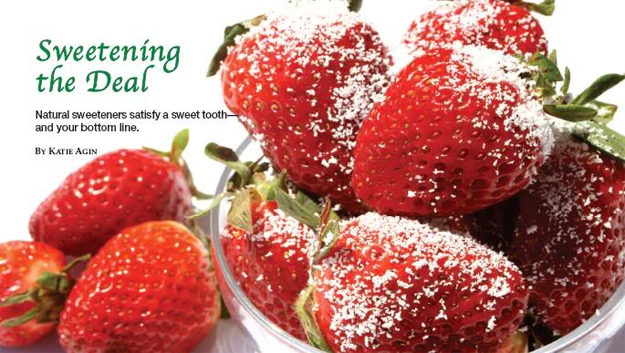The sweeteners category is ever evolving as consumers’ desires transition from low-/no-calorie sweeteners to low-carb to all-natural and back again. But more and more, consumers are recognizing the risks associated with artificial sweeteners and diets high in refined sugar and are flocking to products in the natural sweeteners market like kids to a candy store.
Lately, stevia products have been at the forefront of this trend, although the sweetener has been in our industry for decades before, and might be acting as a category driver. “This category has often been driven by families with young children and by people with health conditions leading them to seek alternatives. With more mainstream companies jumping onto the stevia bandwagon, this category’s audience is growing,” says Neil E. Levin, CCN, DANLA, nutrition education manager for NOW Foods, Bloomingdale, IL. It’s not certain whether consumers’ demand for natural sweeteners was fueled by the emergence of stevia in the mainstream market or if rising national health concerns have caused the market to explode in general. Either way, the category is booming.
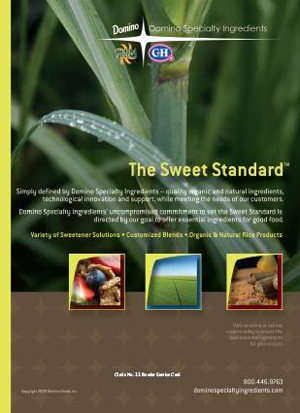 In addition, cost is no longer a barrier for consumers. According to Wes Crain, vice president of Navitas Naturals, Novato, CA, “The prices for alternative sweeteners appear to be dropping and becoming more competitive with conventional sweeteners, in part due to more brands entering the market and supply chains that are maturing and developing a more efficient ‘economy of sale’ for their operations.”
In addition, cost is no longer a barrier for consumers. According to Wes Crain, vice president of Navitas Naturals, Novato, CA, “The prices for alternative sweeteners appear to be dropping and becoming more competitive with conventional sweeteners, in part due to more brands entering the market and supply chains that are maturing and developing a more efficient ‘economy of sale’ for their operations.”
Although stevia has taken the spotlight as of late, there are many other delicious options to satisfy every type of sweet tooth.
Using without Losing
Versatility is important when it comes to consumers’ needs in natural sweeteners: consumers want to sweeten their coffee and tea, but they also want to be able to cook and bake with them. Many consumers turn to artificial sweeteners for a low-calorie solution only to find that recipes have a strange aftertaste or texture, in addition to possible health risks. Also, “Studies have indicated that artificial sweeteners may backfire by shutting down the satiety signals that tell us when we’re full…in those studies, the groups fed artificial sweeteners ate up to three times the calories as the control groups,“ says Levin.
Limitations of sweeteners, natural or otherwise, can be stability, loss of bulk, aftertaste, lingering sweetness and maximum sweetness intensity response, says Sidd Purkayastha, Ph.D., technical director for PureCircle USA, Inc., Oak Brook, IL. “Protein-based sweeteners face more limitations as they are sensitive to pH levels and temperatures that are common for food processing, thus, many of them suffer from a shorter shelf life,” he says.
Some sweeteners can’t be used in cooking and even become dangerous when raised to a certain cooking temperature, being stored or eaten. Artificial sweeteners can be particularly troublesome. Aspartame, which is best stored at low temperatures (as diet soda is expected to be), is very unstable and affected by pH, temperature and moisture conditions. This makes sense when the diet soda is still in the fridge, but when ingested (remember, the average body temp is a not too chilly 98.6°F), a percentage of aspartame is released as methanol, which is metabolized into formaldehyde and formate. Although it would take hundreds of cans of diet soda to reach harmful levels, it’s still concerning when considering how much soda many Americans drink everyday.
Thankfully, there are plenty of natural sweeteners that can be safely used in various applications, including baking. Says Loren Miles, CEO of Natur Sweeteners, Inc., Los Angeles, CA, Natur Sweeteners’ Baker’s Blend platform is a “patented, natural, low-calorie, low-glycemic baking format that rises, caramelizes and provides a crust like sugar.” Stevia sweeteners can also be used in baking. “Being highly stable for a wide range of pH and temperature, stevia sweeteners can be used in a large range of products,” says Purkayastha.
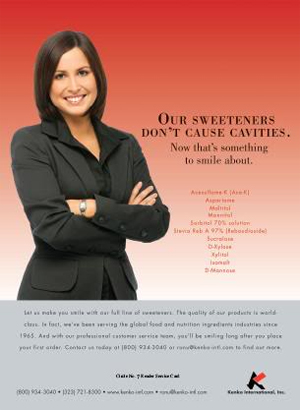 However, because stevia extract is so much sweeter than sugar, much of the volume in recipes can be lost, a common problem with many high-intensity sweeteners. Retailers should be prepared to answer this question and can suggest tofu and applesauce as some common ingredients that add extra bulk to recipes.
However, because stevia extract is so much sweeter than sugar, much of the volume in recipes can be lost, a common problem with many high-intensity sweeteners. Retailers should be prepared to answer this question and can suggest tofu and applesauce as some common ingredients that add extra bulk to recipes.
For those afraid to venture too far from conventional sugar or who have trouble with volume replacement in recipes, retailers can suggest palm sugar as a great option. Crain notes it “is very versatile and can be used as a 1:1 replacement for cane sugar. It has a pleasant caramel-like flavor that is slightly less sweet than sugar, it bakes well, dissolves in hot and cold water, and does not have an overpowering flavor profile to throw off recipes that typically use sugar or conventional sweeteners.” Navitas Naturals’ Sweet Tooth Organic Palm Sugar is naturally lower on the glycemic index with a rating of 35, as compared to honey (GI 55) and cane sugar (GI 68).
Comparable to stevia as a low-calorie, heat-stable and low-glycemic index sweetener, is extract of luo han guo, a very sweet fruit native to China.
Another low-glycemic option is sugar alcohols, or polyols, such as erythritol and xylitol, which can vary in sweetness and absorption. Neither sugar nor alcohol, these compounds are actually carbohydrates that are not completely absorbed by the gut. As a result, “Sugar alcohols don’t raise blood sugar as rapidly as sugar does, yet they’re as bulky as sugar so they can be used spoon for spoon to replace sugar,” says Levin. He also adds that many sugar alcohols tend to have a cooling effect in the mouth and actually taste better when combined with a different type of sweetener. This is the case with erythritol, which is often used in combination with stevia to enhance its flavor profile. For example, Cargill’s Truvia sweetener is enhanced with erythritol.
Xylitol is a great standalone substitute for sugar, although it has some properties that restrict its use in all applications. For example, it can be used for baking, but will not work when baking with yeast, since the yeast cannot metabolize the sweetener, says Brian Craig, vice president of international sales and marketing for Xlear, Inc., Orem, UT. However, he continues, “We have seen growth in the past several years for xylitol, as a result of the culinary possibilities and xylitol’s health benefits.”
However, the amount of sugar alcohols absorbed from the GI tract may create somewhat of a laxative effect at high levels, which can vary from person to person. “Sorbitol may be laxative at moderate levels of 10 grams or more, mannitol at over 20 grams; xylitol at over 30 grams. Erythritol is virtually free of a laxative side effect even at higher levels, but is expensive,” says Levin. NOW Foods sells a wide variety of natural and alternative sweeteners: organic agave nectar, barley malt powder, organic brown rice syrup, beet sugar, date sugar, dextrose, fructose, lactose, organic grade B maple syrup, organic sucanat and organic turbinado sugar.
A more traditional sweetener, agave nectar, is typically thought of as a sweetener in teas, smoothies and sodas, but can also be used in cooking applications. Although agave nectar is not low-cal and has about the same calories as sugar, it’s sweeter, so less may be needed. The syrup can easily be used as a calorie-reducing sweetener in cakes, sauces, cookies and salad dressings. With a neutral taste and smooth consistency, vegans can enjoy plant-derived agave without concerns of honeybee exploitation. Because agave is a tough, low-irrigation crop, it is ideal for organic production.
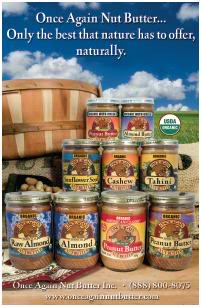 For customers who prefer traditional sweeteners, organic and natural sugars are still great options. Florida Crystals offers 2-lb poly bags of organic cane sugar, natural cane sugar and Demerara cane sugar; 16-oz. bags of Organic powdered sugar; organic and Demerara cane sugar sticks; and 24-oz. bags of Organic light brown sugar. The company also offers organic and natural evaporated cane juice, another ideal alternative to refined white sugar.
For customers who prefer traditional sweeteners, organic and natural sugars are still great options. Florida Crystals offers 2-lb poly bags of organic cane sugar, natural cane sugar and Demerara cane sugar; 16-oz. bags of Organic powdered sugar; organic and Demerara cane sugar sticks; and 24-oz. bags of Organic light brown sugar. The company also offers organic and natural evaporated cane juice, another ideal alternative to refined white sugar.
A Taste of Some Sweet Health Benefits
If not for the sake of their waistbands alone, Americans are transitioning to natural sweeteners for a myriad of health reasons. Crain says, “Many people are avoiding conventional sweeteners such as corn syrup and cane sugar due to ‘empty’ calories, over-processing, dental concerns, high-glycemic indexes and environmental issues associated with their harvesting and production.”
One sweetener, xylitol, has been particularly noted for its health benefits, especially for oral and dental health. “Xylitol is being used as a standalone product, as well as a functional ingredient in a variety of products,” says Craig. “When you use Xlear’s Spry products or SparX candy, the acid attack that would otherwise last for over half an hour, is stopped. Because the bacteria in the mouth causing caries are unable to ferment xylitol in their metabolism, their growth is reduced. The number of acid-producing bacteria may fall as much as 90%. Since no acid is formed, the pH of saliva does not fall. After taking xylitol, the bacteria do not stick well on the surface of the teeth and the amount of plaque decreases. Research has shown that the use of xylitol gum or mints prevents tooth decay and strengthens the enamel by increasing calcium absorption.”
Stevia has also been noted for its positive effects on health, especially when compared to artificial sweeteners or refined sugar. “Different forms of stevia offer varying health benefits from regulating blood sugar and lowering high blood pressure, reducing oral bacteria that cause tooth decay and gum disease, relieving upset stomachs to healing skin problems,” says James May, president and CEO of Wisdom Natural Brands, Gilbert, AZ. Typically, these benefits are associated with whole-leaf stevia products, rather than the extracted chemical compound, rebaudioside A, often referred to as rebiana or Reb A.
These health benefits may be due to the plant’s antioxidant content, as well as its vitamin and mineral content. Levin says, “NOW Foods produces a whole leaf, full-spectrum extraction of stevia to preserve the many phytonutrients naturally present in the plant. One study reported over 100 natural stevia phytonutrients; the majority being polyphenols and other plant antioxidants.”
How a product is made is also essential for retaining the nutrient content in the leaves. Crain adds, “Sweet Tooth Organic Green Stevia is a premium raw stevia in the pure, traditional whole-leaf form like that used in South America. After the stevia leaves used in our product are collected, they are dried and milled into a fine green powder at low temperatures to protect the nutrients of the plant.”
Also, soaking or gently cooking the leaves in water for a long time produces liquid stevia sweeteners. According to May, “This produces a rather dark liquid that retains all of the 100 nutrients, including the glycosides that exist naturally in stevia leaves. This form of stevia, formulated to the correct brix [a measurement of the dissolved sugar-to-water mass ratio of a liquid], has numerous health benefits to the human body, both internally and when used topically. However, because it is dark and has a pronounced licorice taste, it is more of a medicinal/healing product rather than a desirable sweetener. Traditionalists, however, often prefer this form of stevia.”
Wisdom Natural Brands offers more than 20 consumer stevia products in both powdered and liquid forms, as well as its SweetLeaf High Intensity Sweetener, marketed as an ingredient to food and beverage manufacturers, and when mixed with the prebiotic soluble fiber, inulin, as a tabletop sweetener.
 According to Jim Morano, vice president of operations at Suzanne’s Specialties, Inc., New Brunswick, NJ, molasses is also considered a better sweetener option because it still has some nutritional value.
According to Jim Morano, vice president of operations at Suzanne’s Specialties, Inc., New Brunswick, NJ, molasses is also considered a better sweetener option because it still has some nutritional value.
For a more exotic option to molasses, yacon syrup has a “molasses-like flavor” says Crain, and can be blended easily into hot drinks or cold drinks, like smoothies. He continues, “Yacon contains inulin, a complex sugar that breaks down slowly in the digestive tract and helps promote prebiotics in the colon. It is an excellent source of nutrients including bioavailable protein, potassium, vitamins A and C, calcium, iron and phosphorus, as well as fiber.”
In addition to its Yacon Powder, Navitas Naturals offers vegan, raw, organic and gluten-free Lucuma Powder. This sweetener, which is low on the glycemic index is made from a nutrient-rich fruit native to Peru and is a popular flavor of ice cream, beverages and other recipes in South America. For those with sensitive diets, brown rice nectar can offer a solution. “We make a line of brown rice syrups that have the functional properties of corn syrup without being refined,” says Morano. Because rice is considered a hypoallergenic food, brown rice nectar is ideal for consumers with sensitive diets. It is gentle on the body, says Morano. Suzanne’s Specialties offers organic brown rice syrups, organic blackstrap molasses, organic honey, organic agave nectar, organic barley malt extract and organic and natural sugar.
The Sweet and the Sour
The business of sweeteners isn’t always so sweet. Many products and ingredients are constantly under fire from various corners of the natural products industry, regulators and consumers.
Controversy, naturally. Despite the attractive flavor, color and nutritional profile of evaporated cane juice, the term itself has been highly scrutinized. Evaporated cane juice is about 99% sucrose; basically, sugar that hasn’t been refined. Morano suggests that consumers may be confused by the term when buying finished products containing the ingredient, because they may not understand the true sugar content.
Also, the FDA recently issued a draft guidance on ingredients declared as evaporated cane juice, deeming the terminology unlawful because the name is false and misleading on product labels, emphasizing that it is not “juice” by the FDA definition, and would more accurately be called “dried cane syrup.” Comments for the final guidance are being accepted until December 7, 2009.
Stevia struggles. Sweetener squabbles haven’t just been isolated to those involving governmental bodies, however. Intra-industry quarrels have risen out of the stevia craze and its related products, too. For example, Morano wonders how much can something be tampered with before it is no longer considered natural, saying that the isolated/fractionated compound, Reb A, may not be any more natural than aspartame.
Indeed, when it comes to stevia, there seems to be a great divide even amongst its greatest fans. Stevia sweeteners are made up of the whole leaf or they are purified down to particular glycosides, which can dramatically affect the flavor. Some say that whole leaf stevia has a licorice-like aftertaste, while others argue that some of the fractionated rebiana products leave their own chemical aftertaste. A common solution has been to use sugar alcohols, such as erythritol, as a masking agent and also as a bulking agent for tabletop sweeteners.
Purkayastha of PureCircle says, “The whole leaf has a different taste and sweetness because it includes some proteins, glycoproteins, pigments and carbohydrates; the extracted and purified sweeteners from stevia leaves have relatively very little of those impurities, thus, imparts a cleaner sweetness profile.” PureCircle offers a high-purity sweetener of 97% Reb A that is up to 400 times sweeter than sugar and is safely consumed by diabetics and those who wish to avoid calories. The company also offers Reb A 75, a mixture of highly purified sweet glycosides isolated from the stevia plant with a Reb A content of not less than 75%. This sweetener can be used in many applications and is 150 times sweeter than sugar. PureCircle’s sweeteners are used by Whole Earth Sweeteners, manufacturer of the finished product, PureVia.
Reader Service No. 8
A magical production method and/or flavor masker/modifier have become quite the holy grail in the stevia market. The purpose of flavor modifiers is three-fold: to enhance sweetness, reduce bitterness/off notes and enhance mouthfeel, says Pukayastha. “The challenge has been that there is no ‘silver bullet’ flavor modifier that can be used consistently for all three purposes across all applications.”
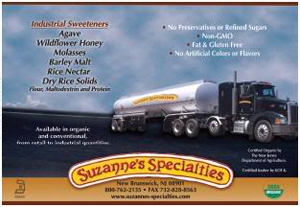 The dilemma has had an interesting affect on the market. It has caused many companies to create their own flavor maskers or to turn elsewhere for a solution, forging partnerships with industry suppliers. Raw materials suppliers have recently launched a range of masking products such as Wixon’s Mag-nifique, Purac’s FIT Plus, and Comax’s stevia masking flavor as part of its Special Effects line of problem solvers.
The dilemma has had an interesting affect on the market. It has caused many companies to create their own flavor maskers or to turn elsewhere for a solution, forging partnerships with industry suppliers. Raw materials suppliers have recently launched a range of masking products such as Wixon’s Mag-nifique, Purac’s FIT Plus, and Comax’s stevia masking flavor as part of its Special Effects line of problem solvers.
Other companies maintain their “purist” production methods. May of Wisdom says his product needs no masking agent because “no chemicals, alcohols, solvents or foreign materials ever touch our leaves or product in any phase of the extraction and purification process. We only use cool, purified water and a revolutionary new filtration technology that results in absolutely high-intensity sweetener comprised of specific naturally-occurring JECFA-approved glycosides that we have selected for inclusion in our sweetener. If stevia sweeteners are produced naturally, they are not bitter nor do they have a lingering bad aftertaste, and they have health benefits.”
No matter the production method, retailers should use caution when placing products in the supplement or food aisles. Levin says, “Many stevia products are still only legal to sell as herbal dietary supplements, not as sweeteners. Some companies may think that all stevia products are now approved for use in foods, but that is not true. Retailers should take their cues from the packaging and only carry reputable brands that strictly follow labeling laws. It is primarily the isolated Reb A fraction of stevia that can be used in foods. Most other stevias have not been approved for food use.”
The beverage industry as a whole has been rocked by the rebirth of stevia products; mainstream giants PepsiCo and Coca-Cola thundered onto the stevia bandwagon when the supplement received FDA approval in late 2008. The battle rages on between the Pepsi’s Trop 50 and SoBe Life Waters, which include Whole Earth’s PureVia; and Coca-Cola’s new line of Odwalla juice drinks, Sprite Green and Vitamin Water 10 products, which utilize Cargill’s Truvia.
The ripple effect from these mainstream products will undoubtedly reach natural products stores, and some say it already has. Sales in natural sweeteners will most likely continue to rise as mainstream consumers test out natural retail stores searching for the latest trend in sweeteners. Retailers should take the opportunity to answer questions about these products, and others, sweet-talk them a bit and maybe gain a lifelong customer, too. WF
Published in WholeFoods Magazine, December 2009

